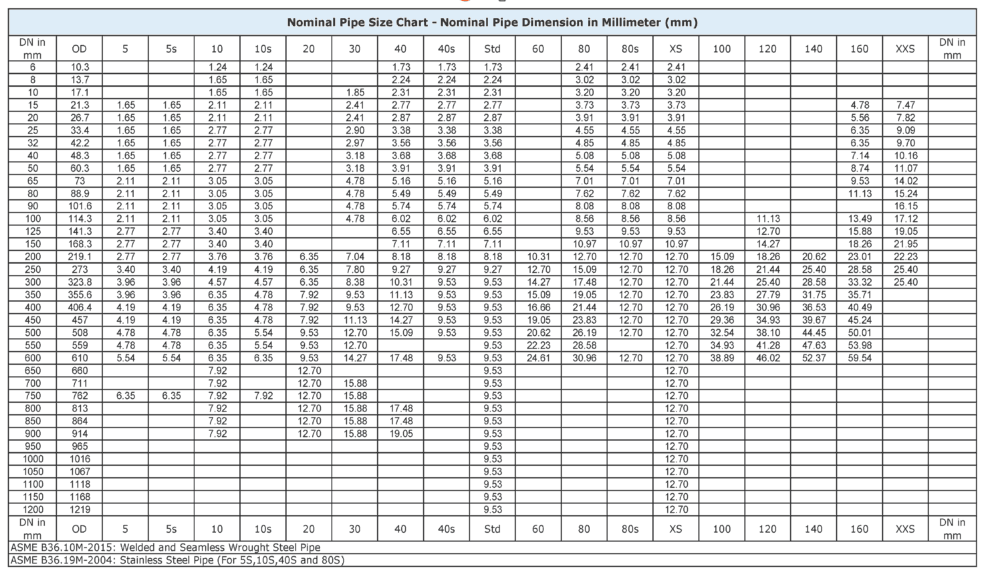Ductile iron pipe (DIP) weight varies primarily with nominal diameter and wall-thickness (class) per AWWA C151. For the most common “Class 53” (ANSI/AWWA C151/A21.51), weight per foot ranges from about 11.4 lb/ft for 3″ pipe up to 370.5 lb/ft for 48″ pipe. When filled with water, total weight can more than double (e.g. 15.2 lb/ft to 1199.4 lb/ft for those same sizes). Variables like cement mortar lining (AWWA C104), special pressure classes, joint types and coatings further affect overall weight.

1. Standard Weight Chart (Class 53, AWWA C151)
The following table shows nominal sizes from 3″ to 12″ (Class 53). “Weight per Foot” is the steel weight alone; “Weight + Water” adds 62.4 lb/ft³ of water (the pipe’s internal volume × water density).
| Nominal Size (in) | O.D. (in) | Wall Thk. (in) | Weight per ft (lb) | Weight + Water per ft (lb) |
|---|---|---|---|---|
| 3 | 3.96 | 0.31 | 11.40 | 15.20 |
| 4 | 4.80 | 0.32 | 14.40 | 20.30 |
| 6 | 6.90 | 0.34 | 22.20 | 35.30 |
| 8 | 9.05 | 0.36 | 31.50 | 54.50 |
| 10 | 11.10 | 0.38 | 41.10 | 77.50 |
| 12 | 13.20 | 0.40 | 51.60 | 103.90 |
For larger diameters (14″–48″), weight increases steeply:
| Nominal Size (in) | O.D. (in) | Wall Thk. (in) | Weight per ft (lb) | Weight + Water per ft (lb) |
|---|---|---|---|---|
| 14 | 15.30 | 0.42 | 63.60 | 134.70 |
| 16 | 17.40 | 0.43 | 74.30 | 167.40 |
| 18 | 19.50 | 0.44 | 85.40 | 203.30 |
| 20 | 21.60 | 0.45 | 96.90 | 242.70 |
| 24 | 25.80 | 0.47 | 121.10 | 442.30 |
| 30 | 32.00 | 0.51 | 163.80 | 487.80 |
| 36 | 38.30 | 0.58 | 219.50 | 688.80 |
| 42 | 44.50 | 0.65 | 285.20 | 920.10 |
| 48 | 50.80 | 0.72 | 360.30 | 1189.20 |
2. Factors Influencing Pipe Weight
-
Thickness Class: AWWA C151 defines multiple thickness classes (e.g. 51 for 3″–4″, 50 for 6″–54″). Higher class → thicker walls → heavier pipe .
-
Cement Mortar Lining: Per AWWA C104, standard cement lining adds up to 1/8″ thickness inside, slightly increasing weight and reducing I.D. .
-
Pressure Class: Some applications use pressure classes (e.g. 150 psi, 350 psi), each with specific wall thickness and weight per foot.
-
Joint & Coating: Mechanical-joint bells, Tyton® joints or bituminous coatings add marginal weight.
-
Lining & Coating Systems: Epoxy or polyethylene sleeving further increases the installed weight.
3. Estimating Weight: Basic Formulas
-
Steel Weight per Foot:
Wpipe=π4 (OD2−ID2)×ρDI×12W_{\text{pipe}} = \frac{\pi}{4}\,(OD^2 – ID^2)\times \rho_{\text{DI}} \times 12Wpipe=4π(OD2−ID2)×ρDI×12
where ρ<sub>DI</sub> ≈ 491 lb/ft³ (ductile iron) . -
Water Weight per Foot:
Wwater=0.4333×(I.D. in inches)2W_{\text{water}} = 0.4333 \times (I.D.\,\text{in inches})^2Wwater=0.4333×(I.D.in inches)2. -
Total Weight = W<sub>pipe</sub> + W<sub>water</sub>.
4. Why Pipe Weight Matters
-
Structural Design: Supports, hangers and bedding must accommodate dead load.
-
Handling & Installation: Determines crane/trolley capacity and crew requirements.
-
Transportation Costs: Heavier pipe → higher freight expenses.
-
Cost Estimation: Unit weight drives material cost per linear foot.
5. FAQ
Q1: What is the weight of an 8″ ductile iron pipe per foot?
A: For Class 53 (AWWA C151), an 8″ DIP weighs 31.5 lb/ft alone and 54.5 lb/ft filled with water.
Q2: How do I calculate the weight of DIP not listed in standard tables?
A: Use the cross-sectional formula above with the pipe’s OD/ID and DI density. Add lining and joint weights separately if needed.
Q3: Does cement lining add significant weight?
A: Standard cement mortar lining (AWWA C104) adds roughly 1/16″–1/8″ to wall thickness, increasing pipe weight by about 5–10% depending on diameter.
Q4: Are weight tables different for pressure-class pipe?
A: Yes—pressure classes (e.g. 150 psi, 350 psi) have their own minimum thickness requirements and weight charts as per AWWA C151 pressure-class tables.
Q5: Where can I find the full weight table for all DIP sizes?
A: The complete ANSI/AWWA C151 weight tables for thickness and pressure classes are published in manufacturers’ data sheets (e.g., EJ Prescott, McWane) and AWWA manuals.
References:
- AWWA C151: Ductile-Iron Pipe, Centrifugally Cast, for Water – American Water Works Association
- AWWA C104: Cement-Mortar Lining for Ductile Iron Pipe and Fittings – American Water Works Association
- Ductile Iron Pipe – Wikipedia
- Water Infrastructure Materials: A Review of Their History and Performance – National Academies Press
- Ductile Iron Pipe Weight Calculator and Technical Resources – McNichols
